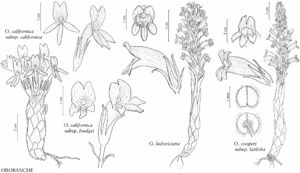Orobanche californica subsp. californica
Plants simple or branched from below ground, 5–20(–27) cm, portion proximal to inflorescence 1–14 cm, slender. Inflorescences corymbs, sometimes subcorymbose or subcapitate racemes, 4–8 cm; bracts purple tinged, drying blackish purple. Pedicels 0–10 mm. Calyces 8–17(–24) mm, lobes purple tinged, drying blackish purple, subulate to linear-subulate, 6–20 mm. Corollas dark purple or red-purple distally, (22–)25–40(–55) mm, tube slender, abruptly widening toward throat; throat 8–10 mm wide at base of lobes; lips 10–14(–18) mm, abaxial lobes lanceolate to oblong, 3–4(–5) mm wide, apex acute to obtuse, adaxial lobes oblong-ovate, apex broadly obtuse to acute, shallowly retuse, or erosulate. 2n = 48.
Phenology: Flowering (Mar–)May–Sep(–Oct).
Habitat: Rocky banks, sand flats, tidal marshes, coastal prairies and slopes.
Elevation: 0–100 m.
Distribution
B.C., Calif., Oreg., Wash.
Discussion
Subspecies californica is uncommon on rocky banks, sand flats, and slopes near the sea from southwestern British Columbia, San Juan Islands, and adjacent mainland Washington, and to coastal prairie and bluff tops in California from Humboldt County south to San Luis Obispo County. Available habitat in the southern portion of the range is adversely affected by infestations of Carpobrotus edulis (Aizoaceae).
The primary host for subsp. californica is Grindelia (Asteraceae). Reports on Ambrosia chamissonis, Erigeron glaucus, and Heterotheca villosa need confirmation.
Subspecies californica is fairly discrete and easily recognizable throughout most of its range. The deep lavender to reddish purple exterior of the corolla, long corolla tube, and long lips are unique to this taxon. The maritime habitat is shared with several other taxa in California: Orobanche californica subsp. grandis, O. parishii subsp. brachyloba, and O. robbinsii; however, the microhabitats and primary hosts of each differ markedly, with subsp. californica the only one of these primarily on coastal prairie, especially blufftop (marine terrace) habitat, and primarily parasitic on Grindelia.
Morphological variation within subsp. californica is partially correlated with geography. Along the central California coast, plants usually have corollas 35–55 mm with broad lobes, apically rounded, and deep purple. The plants of coastal Oregon, Washington, and British Columbia have shorter and narrower corollas (25–35 mm), often with pointed lobes and slightly paler color.
Selected References
None.
